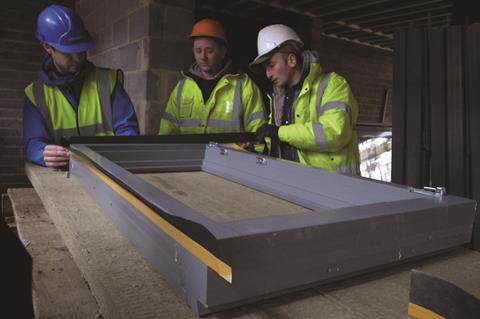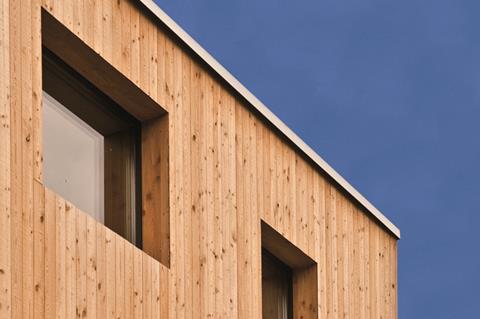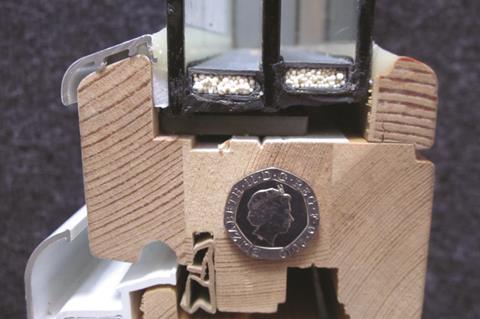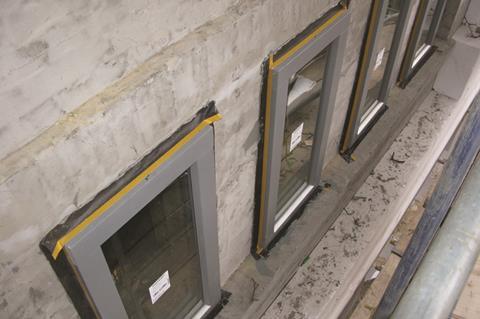Triple glazing is no longer the preserve of environmental zealots, it has become a practical and accessible way to reduce energy loss in buildings and hit environmental targets. Building guides you through the market and latest developments
Choosing triple-glazed windows
Window technology has now progressed so far that good quality triple glazing can admit more energy to a building than will escape over the annual cycle, so long as the solar access is fair. This remarkable fact is one of tenets that enables Passivhaus designers to create buildings with very low heating demands, while providing high levels of comfort to the occupiers.
Until recently triple glazing was seen as an expensive specialist product used only by environmental zealots. But as energy efficiency requirements within the construction become increasingly challenging, triple glazing is establishing itself within the mainstream glazing market. Anyone who visited Ecobuild this year would have seen a dizzying number of triple glazing systems on offer.
With so many options to choose from, here’s a guide to navigating the potentially mind boggling market place.

Where to start
The number of suppliers in the UK is already large and it’s growing, so for those who are new to this area, drawing up a list of suppliers may require a little searching.
As good a place as any to begin might be with the Passivhaus Institute (PHI) at www.passiv.de. This provides a database of companies that sell PHI certified systems. While the contact details are for Germany, most of these companies have distributors in the UK. Certified systems all achieve a U-value for the whole window (U-window) of better (less) than 0.80W/m2K.
Of course there other products not certified by PHI, many of which will perform very well, but you might have to work a little harder to assemble all the performance data from the supplier to make like-for-like comparisons with other products.
Another useful port of call is the Green Building Store in the UK, which acts as a distributor for a number of certified and non-certified systems, as well its own system that it manufactures in the UK. Double Good Windows (a spin-off from Bere architects) distributes a German system and can offer very good technical advice.
Before approaching suppliers it makes sense to reach some conclusions on the following:
- Preferred place of manufacture/sale
- Inward or outward openers
- Frame type (timber, plastic, aluminium or composite)
- U-value target for whole window

UK made?
For those hoping to find a completely “home grown” system, a brief word of warning: at present most systems are manufactured outside the UK. Even UK-assembled systems tend to use timber grown and laminated in central Europe, a situation that doesn’t seem likely to change soon.
Green Building Store and Vale Passive Windows Partnership manufacture good quality triple-glazed systems in the UK.
Bear in mind that windows made beyond our shores may be subject to price fluctuations as a result of exchange rate variations. This can present surprises if the actual purchase of the units takes place after the expiry of the original quotation.
Inward/outward opening
Perhaps the most important decision to take is whether to have inward or outward opening casements. Traditionally in the UK windows open outwards, while on the continent they open in. This is a significant point both in relation to system options that will be available and in relation to heat loss. Inward openers generally have the wide face of the fixed frame oriented outwards. This face can be covered with insulation, resulting in an enhanced overall window performance. For outward openers, this optimisation cannot be achieved as successfully.
The new Part L of the Building Regulations offers rewards for designers who can demonstrate that the heat loss attributed to these thermal bridges (known as psi values and denoted by the symbol) has been minimised by design.
For the ardent traditionalist insistent on outward opening, have a look at the Green Building Store’s Ecoplus3 and Ecocontract frames, which provide good performance on a modest budget.


Frame type
One of the characteristics of triple glazed windows is their weight (typically over 30kg/m2 for the glazing). Most systems on the market use a substantial timber frame as the primary material as it provides good structural strength and low thermal conductivity. Higher performance frames have lower conductivity materials such as purenite (a dense insulator that has some structural integrity) laminated within the frame section to reduce heat loss through the frame.
There are also timber/aluminium composite frames, aluminium and UPVC frames available. These tend to have similar frame sizes as the timber ones.
For designers these wide frames can be seen either as help or hindrance depending on your architectural taste, although outward opening windows tend to be more obtrusive that inward openers, where part of the frame can be hidden with insulation.
Recent frame developments using fibre glass offer designers the option of clear sightlines, appearing almost frameless from the outside. These systems use an innovative insulated fibre glass section at the jamb. Pazen Fenstertechnik’s Enersign and Optiwin’s Alphawin are two examples systems that make use of this visually discrete approach.
U-values
Beware of misleading claims. Some glazing distributors quote the mid-pane U-value of the glass (U-glass) as a headline rather than the overall U-value of the window as a whole (U-window).
While triple glazing units commonly have U-glass values of 0.6-0.7W/m2K or even lower, that is only part of the story. With high performance glazing the U-window value can be significantly undermined by the frame performance (U-frame) and even by the additional heat loss due to the spacer bars at the edge of the glass (g).
Early units used aluminium spacer bars but these were particularly prone to heat loss and reduced the glazing performance by as much as 0.2W/m2K (as well as creating the conditions for condensation on the inside). Most manufacturers of triple-glazed units now use much more efficient spacers (Thermix is a common one that uses a plastic spacer wrapped with stainless steel foil) and the additional heat loss due to spacers has been reduced by half or more. g values below 0.040W/mK are seen as good but some manufacturers can go down to 0.022W/mK.
Glass technology has come so far that the frames of triple-glazed windows often perform worse than the glazing, typically 0.6-1.0W/m2K, as most of the frames available are based on timber sections, albeit sometimes thermally broken.
So, if you are provided with U-glass by a supplier, always ask for the U-window value, as this will be required for your thermal model (SAP, PHPP or other). Furthermore ask for confirmation that U-window has been verified using EN 10077. I always ask for U-frame and g as well so that I can verify myself the U-window value in Passivhaus Planning Package Software (PHPP).
Yet another number you will want to obtain is the G-value, which is also required for both SAP and PHPP software. The G-value is a percentage that indicates how much solar energy passes from the outside to the inside. For good solar gain in the cooler seasons a higher G-value is naturally desirable, but you must guard against overheating in the summer with suitable shading. Generally speaking, as the U-value diminishes so does the G-value. Premium units combine the best of both by having a low U-value of 0.6W/m2K and a high G-value of 60%. Passivhaus aficionados will optimise the performance to cost ratio of their triple glazing units using PHPP software.
The Passivhaus Institute has certified many of the triple glazing systems available on the market so also ask if a PHI certificate is available. Their assessment process is rigorous and any system with a valid certificate will provide U-window 0.80W/m2K. Part of the process involves thermal modelling using approved software of the window section.

Gas retention for glazing units
The performance criteria discussed above relate to a new window and it is essential that the performance is maintained over time. As most high performance glazing systems rely on low conductivity gases like argon that are trapped between the panes of glass, the retention of the gas provided by the edge seals is critical.
BS EN 1279 sets out six standards for sealed glazing units. Part 3 requires that the gas concentration must be greater than 90% and that the percentage of gas loss must be less than 1% each year. Check the system you specify meets these requirements.
The gas tightness of units is partly predicated on the robustness of the spacer bars. Plastic spacer bars that are bent at the corners rather that mechanically jointed are recognised as potentially safer but not all manufacturers have the tooling to do this. This is a question worth asking before making a choice.
Airtightness
Windows contribute to heat loss though air leakage as well as conduction. Therefore ensuring that the windows remain airtight for their life is very important. Opening windows should use compression seals all the way around so that when the window is locked, the moving frame and the fixed frame are sealed tight. Having two compression gasket seals on each window enhances the U-value of the window overall by providing a trapped air pocket and ensures that if one seal is damaged or impaired by dirt, there is a second line of defence to air leakage.
Installation
The actual installed performance of a window is dependent on more than just product choice. Poorly designed and installed interfaces can dramatically reduce the over-all effectiveness of a window.
One of the basic rules to ensure optimum performance is to fit the window within the insulation zone and to lap the fixed external part of the frame with the insulation.
Further advice is given in AECB Gold Standard guidance, at www.aecb.net/standards_and_guidance.php and in Details For Passive Houses: A Catalogue Of Ecologically Rated Constructions, by Springer Verlag GmbH.
Similarly, it is essential to ensure an air-tight connection is made between the window and the surrounding wall as this interface is a classic air leakage path. The application of expanding foam has been shown to be only partially successful particularly when the foam is trimmed back to reveal its sponge-like interior.
Professional installations will use proprietary air sealing tapes fitted to the frame prior to installation. One side of the tape will be bonded to the frame edge and the other bonded to the air-tightness layer.
Ironmongery
Most triple glazing systems come with an integrated tilt/turn mechanism and lockable handle. Sometimes the operating gear interferes with the sealing gaskets, which is worth watching out for if you are aiming for very high levels of air tightness. Other systems have part of the operating mechanism exposed to the inside of the room, which may be an issue for the minimalist designer. Ensure that the operating mechanism is easily adjustable so that it can be fine tuned for air-tight sealing.
The finishing touch to all windows are the handles and locks. Most systems come with their own rather clunky looking designs. If that is a problem, check that the mechanism is compatible with a handle of your choice. Sprung lever handles tend not to work with tilt and turn mechanisms as these require a double handle movement for switching between tilt and turn modes.
Robert Prewett is a director of Prewett Bizley architects and Certified Passivhaus designer



























No comments yet